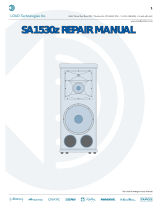
© 2015 Community Professional Loudspeakers page 19
8.4 WEATHER RESISTANCE (Grille information does not apply to BNG models)
All R1s are highly weather-resistant by design. The all-fiberglass enclosure is virtually impervious to the
effects of weather. The grille is designed to prevent rain intrusion into the mouth of the loudspeaker. The R1
grille and supplied yoke are treated with Community’s proprietary dual-layer powder coat process which
includes a zinc-rich epoxy inner layer of extremely durable, corrosion fighting and abrasion resistant
elements, plus a UV-resistant outer layer of polyester powder coat to inhibit fading, peeling and cracking. All
external mounting hardware is stainless steel. The speaker cable gland-nut is made of polypropylene and
approved for outdoor electrical installation. The high frequency HF driver has a titanium diaphragm which is
an inherently weather-resistant material. The low frequency cone has been treated with a hydrophobic
water-resistant coating.
8.4.1 MAINTAINING WEATHER RESISTANCE
There are several things that must be observed when installing an R1 in order to maintain its weather-
resistant integrity for outdoor use.
1. We recommend angling the R SERIES loudspeaker at least 5 degrees downward so as to reduce
the possibility of rain and other precipitation compromising the performance of the loudspeaker.
2. All five mounting holes must be sealed off with the stainless steel bolts, washers, and rubber washers
supplied. If, for any reason, these bolts must be removed, seal off the hole with silicone caulking or
some other suitable weather-tight sealant.
3. The rubber washers supplied with the mounting bolts must always seat against the enclosure.
4. The gland-nut securing the loudspeaker cable to the enclosure is sealed at the factory. Do not attempt
to remove this nut or the weather-tight seal will be broken. If it is desired to replace the gland-nut
with a jack, the jack must be a weather-proof design. It must be suitably sealed to the enclosure with
silicone caulk or some other suitable weather-tight sealant. The Neutrik model NL4MP is an excellent
connector for this purpose. The gland-nut should be at the bottom when mounting. Leave a “drip
loop” so water will not migrate toward the loudspeaker.
5. The grille assembly is designed to prevent normal and wind-driven rain from directly entering the
mouth of the loudspeaker. The grille is not designed to withstand such things as being directly
sprayed from a hose; therefore, this should be avoided.
6. If you use any hardware in place of the stainless steel screws, bolts, nuts, and washers supplied, it
should also be made of stainless steel.
CAUTION: If the above instructions are not observed, the weather-resistant integrity of an R1 can be
compromised. This can result in damage to or failure of the hardware or internal components which
will void the warranty.
8.4.2 MECHANICAL INSTALLATION AND SAFETY
DANGER: The loudspeakers described in this manual are designed and intended to be ‘flown’ or
suspended for maximum acoustical performance using a variety of rigging hardware, means, and
methods. It is essential that all installation work involving the suspension of these loudspeaker
products be performed by competent, knowledgeable persons who understand safe rigging practices.
Severe injury and/or loss of life may occur if these products are improperly installed.
Important Notes on Rigging Loudspeakers
There are three areas of responsibility for rigging loudspeakers. The first is the building structure. Always
consult with the building architect or structural engineer to assure the ability of the structure to support the
loudspeaker system. The second area of responsibility is the loudspeaker itself. Community certifies its
loudspeaker systems for suspension when they are properly installed according to our published guidelines.
The third area of responsibility is everything between the loudspeaker and the building structure and the
actual process of installation. The installing contractor assumes this responsibility. Loudspeaker rigging
should be performed only by certified rigging professionals using certified rigging hardware chosen for the
specific application. Prior to installation, the contractor should present a rigging plan, with drawing and
detailed parts list, to a licensed structural engineer (P.E.) or architect for written approval.




















